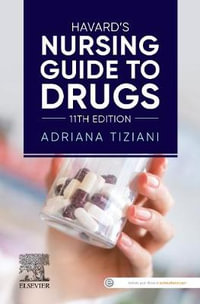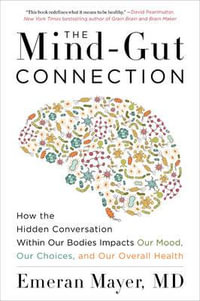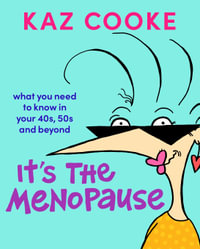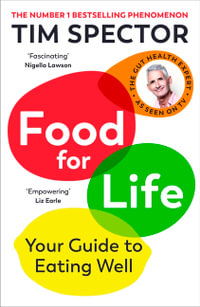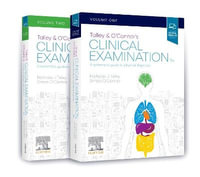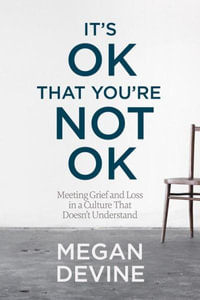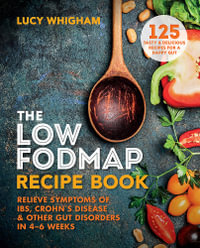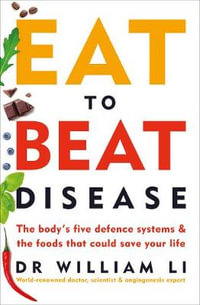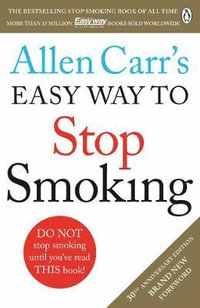
Kids' Food Allergies for Dummies
Australian Edition
By: EDI Tang
Paperback | 10 June 2011 | Edition Number 1
At a Glance
320 Pages
23.5 x 18.7 x 1.8
Paperback
RRP $39.95
$35.40
11%OFF
or 4 interest-free payments of $8.85 with
orAvailable for Backorder. We will order this from our supplier however there isn't a current ETA.
Everything you need to know to look after kids with food allergy
Managing food allergy is vital for the safety of kids in your care. The best defence against a serious allergic reaction is knowledge, and this book provides you with everything you need to know, from prevention and diagnosis through to caring for kids at home, school or away on holidays.
-
Look after your child in your home and on the go ? organise your home and make travel plans that cater for your child's needs
-
Provide a safe environment at school or the childcare centre ? set up your school or centre to manage allergies with confidence
-
Prepare your child to take responsibility for a food allergy ? ensure your child knows about problem foods
-
Know when allergic reactions are serious ? be prepared to treat and manage anaphylaxis
-
Get to grips with the difference between types of food allergy ? identify immediate and delayed food allergies
-
Understand why allergy rates are on the rise ? access the latest research on what causes allergies, and how to avoid them
-
Prepare for allergy testing ? learn how your child is tested and how you can get involved
-
Look into future treatments ? get a grasp on new allergy treatments and possible cures
Open the book and find:
-
Clear instructions for using EpiPens and Anapens
-
Simple explanations about different types of food allergy
-
Information about how to recognise and treat allergic reactions
-
Sample emergency action plans
-
The latest research on finding a cure for food allergy
-
Key lessons to teach children with food allergy
-
Suggestions for food replacements
-
Websites to access further support
Learn to:
-
Keep the home, classroom and childcare centre safe
-
Show others how to care for kids with food allergy
-
Educate kids about helping their friends and themselves
Introduction 1
About This Book 1
What You’re Not to Read 2
Foolish Assumptions 3
Conventions Used in This Book 4
How This Book Is Organised 4
Part I: Introducing Food Allergies 4
Part II: Defining Food Allergies 5
Part III: Living with Food Allergies 5
Part IV: Looking To the Future with Allergies 5
Part V: The Part of Tens 5
Icons Used in This Book 6
Where to Go from Here 6
Part I: Introducing Food Allergies 9
Chapter 1: Finding Out How Food Can Make Kids Sick 11
Describing Food Allergies in Kids 12
Reacting badly to food 12
Defining the difference between food allergies and intolerances 13
Pointing the finger at common allergies in kids 13
Busting myths about anaphylaxis 14
Understanding Why Some Kids Have Allergies and Others Don’t 15
Getting a Grip on Allergy Jargon 16
Understanding allergies and allergic reactions 16
Comprehending allergic diseases 17
Defining atopy 20
Taking on the atopic march 21
Watching Allergy Rates Rise 22
Foiling Food Allergies: Prevention versus Cure 23
Knowing the Symptoms 24
Testing Times: Finding the Cause of Allergic Reactions 25
Checking for immediate food allergies 26
Testing for delayed food allergies 26
Managing Allergies Day by Day 27
Supporting Parents, Schools and Kids 28
For parents 29
For schools and childcare centres 29
For kids 30
Looking to the Future 31
Chapter 2: Investigating the Rising Rates of Food Allergies 33
Examining Recently Rising Rates of Food Allergies and Other Allergic Diseases 34
Food allergy increases in Aussie and Kiwi kids 34
Increasing rates of other allergic diseases in Aussie and Kiwi kids 36
Speculating about Why Allergies Are on the Rise 38
Judging genes and food allergies 38
Looking at the immune system’s role in food allergies 39
Being allergic to a Western lifestyle 40
Chapter 3: Preventing Food Allergy in Kids 45
Establishing When Food Allergies Develop in Kids 46
Researching Ways to Prevent Food Allergies 46
Finding Out If Your Child Is at High Risk of Food Allergy 49
Reducing the Chances of Food Allergy Developing in Kids 50
Breastfeed for at least six months 51
Introduce solids at around six months 52
Let babies get down and dirty 53
Get some sunshine in your life 56
Introducing Foods into Baby’s Diet 58
When and how to try new foods 58
Which foods to introduce in what order 60
Part II: Defining Food Allergies 61
Chapter 4: Identifying Immediate Food Allergies 63
Explaining Immediate Food Allergies 64
Understanding mild to moderate allergic reactions 65
Demystifying anaphylaxis 66
Contemplating Common Food Allergies 69
Examining eggs 69
Considering cow’s milk 73
Picking out the peanuts 74
Studying the Not-So-Usual Suspects: Other Food Allergies 76
Threshing out wheat allergies 77
Sorting out soy allergies 78
Hooking up with fish allergies 79
Prying into shellfish allergies 81
Cracking open tree nut allergies 83
Exploring rare allergies 84
Oral Allergy Syndrome 86
Chapter 5: Discovering Delayed Food Allergies 87
Explaining Delayed Food Allergies 88
Understanding the difference between IgE and non-IgE allergies 88
Looking for the right symptoms 89
Watching the timing of symptoms 91
Identifying the age when delayed food allergies begin 92
Diagnosing delayed food allergies 93
Finding Out Which Foods Cause Tummy Upsets 93
Distinguishing Between Cow’s Milk Allergy and Lactose Intolerance 94
Considering how cow’s milk allergy leads to lactose intolerance 94
Looking at lactose intolerance 96
The Irritable Infant 97
Contemplating colic 97
Reflecting on reflux 98
Concerning constipation 99
Thinking about eczema and eating in infancy 100
Understanding that your breast milk is composed of what you eat 101
Chapter 6: Testing for Food Allergies 103
Comparing Testing for Immediate and Delayed Food Allergies 104
Testing for IgE Mediated Food Allergies 104
Using skin prick tests 105
Checking blood samples for allergen-specific IgE antibodies 109
Challenging food allergies in hospital 111
Checking for Delayed Food Allergies 112
Undertaking a home elimination and challenge test 113
Using patch tests 115
Scrutinising Unproven Tests 116
Part III: Living with Food Allergies 117
Chapter 7: Managing Food Allergies 119
Knowing the Four Elements of Food Allergy Management 120
Avoiding the Foods that Cause Troubles 120
Reading ingredient labels 121
Sidestepping allergens with alternative foods 122
Minimising the Risk of Accidental Exposure 125
Knowing when accidental exposure occurs 126
Dodging accidental allergens 127
Being cautious without imposing too many restrictions 129
Treating Allergic Reactions 130
Recognising allergic reactions 131
Deciding on your treatment options 131
Adrenaline auto-injectors 133
Managing Conditions and Medicines That Can Make Allergy Reactions Worse 136
Enlisting the Help of a Dietitian 137
Chapter 8: Caring for Kids at Home and On the Go 139
Shopping for Kids with Allergies 140
Making sense of ingredient labels 140
Recognising which products can be contaminated 147
Preparing Food in the Home 148
Cooking meals 148
Storing food 150
Cleaning the kitchen and home 150
Travelling with Food Allergic Kids 150
Flying with confidence 151
Travelling in developing countries 152
Eating Out with Kids with Food Allergies 154
Calling ahead to restaurants 154
Eating at friends’ houses 154
Educating Others 155
Understanding the issues you should discuss 156
Talking to family members and frequent carers 157
Finding ways to discuss allergies 157
Chapter 9: School and Childcare Staff: Caring for Kids with Food Allergies 159
Keeping Kids with Food Allergies Safe at Schools and Child Care 160
Setting allergy policies 161
Keeping health records 162
Developing a risk minimisation plan for children with food allergies 164
Training staff in anaphylaxis management 167
Arranging first aid rooms 168
Responding to an emergency 171
Taking steps after an allergic reaction 174
Communicating Food Allergy Policies 174
Talking to staff 175
Speaking to families of children with food allergies 176
Explaining allergies to other kids 177
Helping parents understand other children’s allergies 179
Dealing with Food in Schools 180
Preparing the classroom 180
Setting up canteens and kitchens 183
Being prepared in the schoolyard 185
Holding functions at school 185
Taking Allergies on Holiday: School Trips 186
Taking a trip 186
Planning for camps 187
Chapter 10: Educating Food Allergic Kids 191
Learning to Manage Your Allergies 192
Knowing the difference between a mild reaction and anaphylaxis 192
What to do if you’re having an allergic reaction 193
Should you use an adrenaline auto-injector or call an ambulance? 193
Telling People about Your Allergies 194
Deciding who to tell 194
Passing on the most important information to your friends 194
Dealing With Peer Pressure and Bullying because of Your Food Allergies 197
Taking Your Medications 198
Learning how to take your medication 198
Taking your medication with you 199
Earning Your Independence: Going Out as a Teenager with Food Allergy 200
Understanding that teenagers have special needs 200
Knowing the risks: Going to restaurants and staying over with friends 201
Talking to your doctor 202
Chapter 11: Emergency Action Plans 203
Being Prepared for an Allergic Reaction 204
Writing the emergency plan 204
Describing the symptoms of an allergic reaction 205
Listing important phone numbers 206
Managing an Allergic Reaction When a Doctor Isn’t Around 206
Recognising the symptoms of allergic reactions 207
Acting in an emergency 209
Using Emergency Medications 214
Antihistamines 215
Adrenaline 216
Telling Medical Staff What They Need to Know 221
Accessing Additional Support 222
Part IV: Looking To the Future with Allergies 223
Chapter 12: Growing Out of Food Allergies 225
Knowing What to Expect Over Time from Your Child’s Allergies 225
Testing for the development of tolerance 226
Grasping possible reasons behind different rates of allergy resolution 227
Predicting who might grow out of food allergies 228
Safely Reintroducing Problem Foods at Home 229
Knowing when you’re safe to try problem foods at home 230
Introducing problem foods at home 231
Confronting Your Child’s Allergies with Hospital-Based Food Challenges 233
Being Careful With Allergen Avoidance: Trace Amounts in Foods 235
Chapter 13: Treating Allergies in the Future 237
Distinguishing between Tolerance and Desensitisation 238
Tolerance to allergens 238
Desensitisation to allergens 239
Investigating Immunotherapy 240
Administering immunotherapy 241
Trying immunotherapy for food allergies 242
Eating Your Way Out Of Allergies: Oral Immunotherapy 243
Researching ways to induce tolerance 245
Working out if desensitisation is enough 245
Learning About Modified Allergens for Use in Immunotherapy 246
Exploring Other Treatments 247
Food Allergy Herbal Formula 248
Probiotics 248
Other adjuvants and bacterial products 249
Part V: The Part of Tens 251
Chapter 14: Ten Key Lessons to Teach Your Kids About Food Allergies 253
Finding Comfort in Numbers: Many People Have Food Allergies 254
Decoding Labels and Asking Questions 254
Teaching Your Friends a Thing or Two 255
Sitting at the Cleanest Table 256
Eating Off a Plate or Napkin 257
Steering Clear of Sloppy Eaters 257
Avoiding Lunch Room Food Swaps and Food Fights 258
Stocking up on Healthy, Yet Yummy, Snacks 258
Asking for Help Immediately When Feeling Funny 259
Carrying an Emergency Action Plan 260
Chapter 15: Ten (Well, Almost!) Common Food Replacements 261
Replacing Egg in Cooking 261
Finding Alternatives to Cow’s Milk Formula for Babies 262
Swapping Out Cow’s Milk for Older Children 264
Replacing Nuts 265
Removing Wheat 267
Avoiding Soy 268
Replacing Milk and Soy 268
Keeping Away from Fish 269
Sidestepping Shellfish 270
Chapter 16: Ten Myths about Food Allergies 271
Anaphylaxis Can Occur If You Look at a Peanut 271
Touching a Food Can Lead to a Severe Reaction 272
Drinking Soft Drink Is a Treatment for Anaphylaxis 272
Parents of Kids with Food Allergies Are Overanxious 273
Kids with Food Allergies Want to Be Different or Special 273
Overusing Antibacterial Handwash Has Caused the Food Allergy Epidemic 274
Allergies Happen Because We Bubble-Wrap Our Kids 274
Increased Use of Preservatives and Chemicals Causes the Rise in Food Allergies 275
You Can’t Be Allergic to a Banana! 275
Food Allergies Only Affect Kids 275
Chapter 17: Ten (Plus Two!) Top Allergy Websites 277
Allergy New Zealand 277
Anaphylaxis Australia 278
ASCIA 279
Asthma Foundation (Australia and New Zealand) 279
AusEE kids 280
Australian Gut Foundation 280
Coeliac Australia and Coeliac New Zealand 280
Eczema Association of Australasia 281
Food Allergy and Anaphylaxis Network (US) 281
Food Standards Australia New Zealand 281
Ilhan Food Allergy Foundation 282
The Royal Children’s Hospital’s Information for Parents 282
Glossary 285
Index 291
ISBN: 9781742468440
ISBN-10: 1742468446
Series: For Dummies Ser.
Published: 10th June 2011
Format: Paperback
Language: English
Number of Pages: 320
Audience: General Adult
Publisher: John Wiley & Sons Australia
Country of Publication: AU
Edition Number: 1
Dimensions (cm): 23.5 x 18.7 x 1.8
Weight (kg): 0.53
Shipping
| Standard Shipping | Express Shipping | |
|---|---|---|
| Metro postcodes: | $9.99 | $14.95 |
| Regional postcodes: | $9.99 | $14.95 |
| Rural postcodes: | $9.99 | $14.95 |
How to return your order
At Booktopia, we offer hassle-free returns in accordance with our returns policy. If you wish to return an item, please get in touch with Booktopia Customer Care.
Additional postage charges may be applicable.
Defective items
If there is a problem with any of the items received for your order then the Booktopia Customer Care team is ready to assist you.
For more info please visit our Help Centre.
You Can Find This Book In

SIGNED COPY
BLACK FRIDAY
Paperback
RRP $36.99
$22.25
OFF

BLACK FRIDAY
RRP $56.90
$28.50
OFF

BLACK FRIDAY
RRP $34.99
$20.95
OFF
This product is categorised by
- Non-FictionCooking, Food & Drink
- Non-FictionMedicineClinical & Internal MedicineDiseases & DisordersImmunology
- Non-FictionMedicineMedicine in General
- Non-FictionSelf-Help, Personal Development & Practical AdviceHow-toFor Dummies BooksHealth Diet Reference
- Non-FictionFamily & HealthParenting: Advice & Issues

